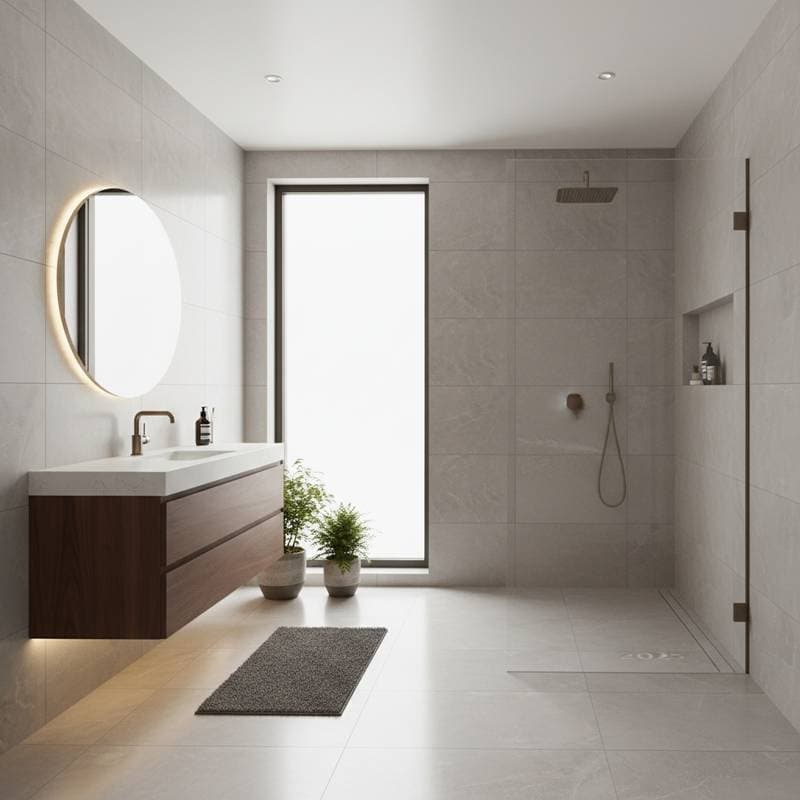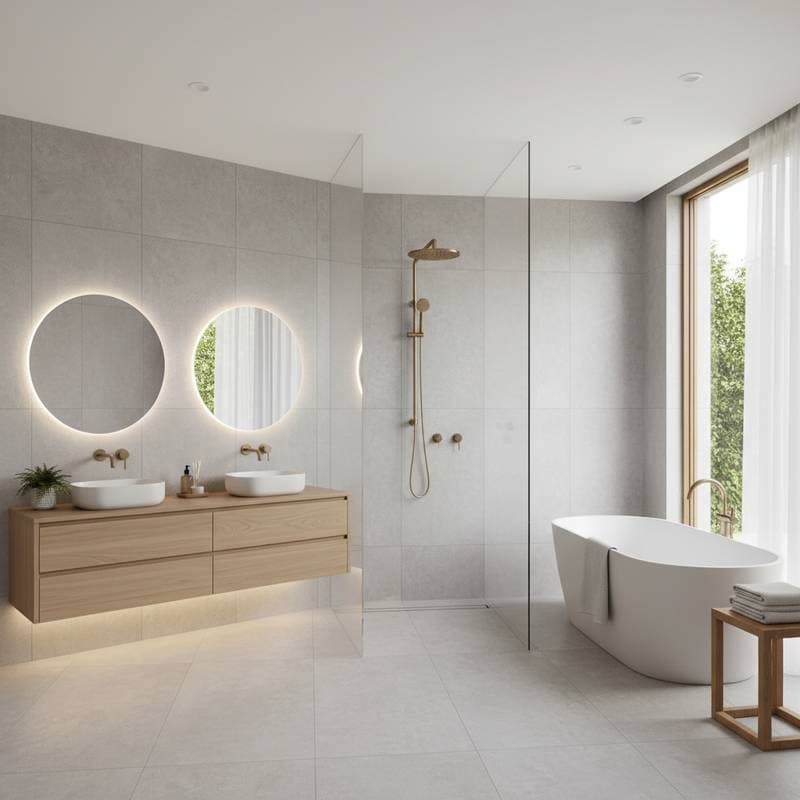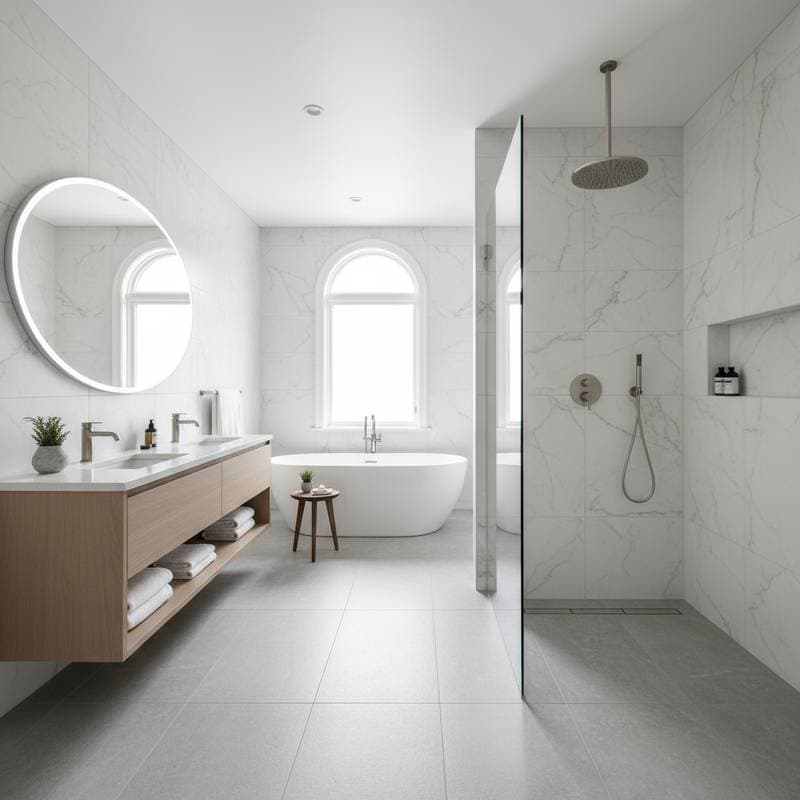Understanding Doorless Showers and Their Rising Appeal in 2025
Doorless showers, also known as walk-in or curbless showers, eliminate traditional doors or curtains to foster a fluid transition between the bathing area and the rest of the bathroom. This design choice expands the perceived size of the space and introduces a contemporary aesthetic that aligns with modern living preferences. Homeowners undertaking renovations in older properties or crafting new wet rooms find these showers particularly suitable for enhancing accessibility and simplifying daily maintenance.
The trend gains momentum in 2025 due to shifting buyer demands for inclusive, low-barrier environments. Real estate experts project that incorporating such features can yield a measurable return on investment, making doorless showers a strategic upgrade for properties aimed at broad market appeal.
Breaking Down Installation Costs
Nationwide, the expense for installing a doorless shower typically falls between $4,500 and $12,000, depending on project scope and materials. Mid-range renovations, which include standard tiling and basic waterproofing, often total $6,000 to $9,000. Luxury installations featuring premium natural stone, advanced linear drains, and extensive custom waterproofing may surpass $15,000.
Several elements influence the final price. Bathroom dimensions and existing layout determine structural adjustments needed. Material selections, such as porcelain versus marble tiles, affect durability and cost. Essential components like drain systems and waterproof membranes require precise engineering to prevent issues. Regional labor rates vary, and adherence to local building codes can add fees for inspections or permits. Optional additions, including frameless glass panels or partial enclosures, further customize and elevate expenses.
Weighing the Advantages and Drawbacks
Doorless showers offer distinct benefits that enhance both daily use and property worth. They visually enlarge compact bathrooms by removing visual obstructions, creating an illusion of spaciousness. Cleaning becomes straightforward, as there are no tracks or seals to accumulate grime. Accessibility improves significantly, accommodating individuals with mobility challenges through barrier-free entry. The overall look evokes a spa-like retreat, appealing to those seeking relaxation and sophistication. During resale, these features attract buyers prioritizing modern, efficient designs.
However, potential challenges warrant consideration. Water may splash beyond the shower area without proper containment, necessitating thoughtful placement. Achieving the correct floor slope for drainage demands precision to avoid pooling. Privacy feels reduced compared to fully enclosed options, which might concern some users. The open design can lead to quicker heat loss, making the space feel cooler during use. Initial investments in robust waterproofing exceed those for conventional showers, though long-term savings in maintenance offset this.
Exploring Design Variations
Selecting the right configuration ensures the shower integrates seamlessly with your bathroom's layout and style. A half-wall design incorporates a low partition on one side, providing splash protection while maintaining an open entry; this suits smaller spaces effectively.
Corner walk-in models leverage two adjacent walls for enclosure, with a single open side for access, ideal for optimizing tight footprints without sacrificing functionality.
Full wet rooms transform the entire bathroom into a tiled, waterproof zone, blurring lines between shower and floor for a minimalist, contemporary vibe; these excel in universal design applications that prioritize inclusivity.
Glass screen options employ a stationary panel to direct water flow while preserving the airy aesthetic, offering a compromise between openness and containment.
Deciding Between DIY and Professional Installation
Doorless shower projects involve intricate tasks that test even experienced hands. Key requirements include expert tiling techniques, application of waterproof barriers, and precise floor sloping to direct water toward the drain. An adept do-it-yourselfer might complete a modest installation in three to five days, utilizing specialized tools such as a wet tile saw, spirit level, grout float, and notched trowel. However, errors in execution can result in persistent leaks, mold growth, or structural damage over time.
Professional involvement proves essential for complex scenarios, such as relocating drains, altering floor levels, or integrating radiant heating. Licensed contractors guarantee adherence to slope specifications, comprehensive waterproofing, and compliance with plumbing codes. Their expertise minimizes risks and ensures the installation withstands daily wear, providing peace of mind for homeowners.
Essential Steps for Installation
Successful doorless shower creation begins with thorough planning. Measure the space to confirm clearances for entry and fixtures, then sketch the layout to visualize flow.
Demolition follows: remove existing shower components, flooring, and any obstructing elements carefully to avoid damaging surrounding structures.
Adjust the drain position if necessary, ensuring it aligns with the intended shower zone for optimal water evacuation.
Apply a waterproof membrane over the subfloor and install cement backing board on walls to fortify against moisture.
Shape the floor with a gentle slope, typically one-quarter inch per foot, directing toward the drain for efficient runoff.
Lay tiles or stone using thin-set mortar, pressing firmly for adhesion and aligning edges precisely.
Apply grout to joints, then seal thoroughly to block water penetration.
Install showerhead, controls, and other fixtures, followed by a thorough test of drainage and leaks.
Finally, clean all surfaces and apply a sealant to grout lines, allowing full curing before regular use.
Upkeep and Expected Durability
Regular maintenance preserves the shower's performance and appearance. Wipe tile and grout surfaces weekly using a pH-neutral cleaner to remove soap residue and prevent buildup.
Inspect caulking biannually for cracks or wear, reapplying as needed to maintain a watertight seal.
Reseal grout lines once a year to guard against moisture infiltration and discoloration.
With diligent care, a well-constructed doorless shower endures 20 years or longer, requiring only occasional repairs to fixtures or minor resealing.
Considering Alternative Approaches
If a full doorless setup does not align with your needs, prefabricated shower kits provide a budget-friendly alternative. These units install quickly with minimal customization, though they limit aesthetic flexibility.
Standard enclosed showers retain heat effectively and offer greater privacy, delivering a more traditional bathing experience at a lower waterproofing cost.
Tub-shower combinations cater to households with diverse users, balancing functionality for children or those preferring soaks, albeit with reduced accessibility for aging residents.
Adapting to Regional Considerations
Climate and location influence design choices for optimal performance. In colder climates, incorporate radiant floor heating to warm tiles and counteract the open design's chill factor.
Coastal environments demand durable, corrosion-resistant selections like porcelain tiles and stainless-steel drains to withstand high humidity and salt exposure.
Always consult local plumbing regulations, which may specify minimum drain sizes, slope angles, or waterproofing protocols to ensure safety and legality.
Calculating Return on Investment and Resale Impact
Investing in a doorless shower positions your home favorably in the 2025 market. Thoughtful execution can elevate property value by up to 11 percent, as buyers increasingly favor bathrooms that maximize space and accessibility.
Appraisers recognize these upgrades for their role in modernizing outdated layouts, broadening appeal to younger families, empty nesters, and universal design enthusiasts alike.
Prioritizing Safety Measures
Safety forms the foundation of any doorless shower installation. Select flooring with a high coefficient of friction, certified for wet environments to minimize slip hazards.
Verify the floor slope complies with code standards, preventing water accumulation that could lead to accidents.
Position electrical outlets well outside the wet zone, adhering to grounding requirements for added protection.
Obtain permits for all plumbing or structural modifications, allowing inspectors to confirm work meets community safety benchmarks.
Executing Your Doorless Shower Project
Embark on your renovation by mapping the layout and verifying waterproofing specifications to align with your vision. Solicit quotes from at least three qualified tile specialists or bathroom remodelers experienced in open designs.
This upgrade delivers enduring value through enhanced comfort, stylish integration, and boosted marketability when professionals handle the details.









